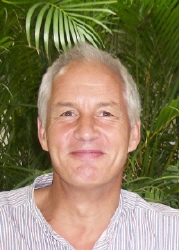|
Breathing ?
Which of the following health conditions is not directly benefited by breathing exercises?
|
|
| | Pause and Appreciate: New Academic Integration Modeled by Georgetown with Bastyr and Others | |
Summary: A model inter-institutional relationship may help bridge the chasm that separates health professions education in conventional academic health centers from institutions educating students for the distinctly licensed integrative practice ("CAM") professions. Says one leader: "I believe we are poised to make an important advance in how the future training of health professionals may evolve." The speaker is Adi Haramati, PhD, integrative medicine leader at Georgetown University, describing a new relationship between Georgetown and Bastyr University relative to Bastyr's naturopathic medical program and Georgetown's MS CAM program. Haramati and his co-director Hakima Amri, PhD are exploring similar relationships with chiropractic schools and other health professions institutions. The developers "would like nothing more" than to see this bridge-building relationship be used as a model for other academic health centers and CAM institutions.
 MS-CAM program leaders initiate relationships
Meantime, Student B is considering naturopathic medical college. The field of complementary and alternative medicine intrigues. But is he or she ready to make the jump for that 4-year, residential commitment? Is naturopathic medicine or regular medical school or chiropractic medical education what they want? Personnel with the naturopathic medical program say: You might consider this year-long Masters of Science in complementary and alternative medicine at this academic health center.
 Naturopathic program the focus of the inter-institutional agreement
A new threshold of mutual respect
While neither binding, nor formal, the Georgetown-Bastyr relationship marks what appears to be a new threshold of mutual respect between a conventional academic program and a "CAM" school.
The relationship was conceived by Aviad "Adi" Haramati, PhD, co-director of the Georgetown program with Hakima Amri, PhD. Georgetown plans to forge similar relationships with vetted, top-quality schools that train professionals for the distinctly licensed complementary and alternative healthcare disciplines.
 Haramati: Long involvement in building bridges between disciplines
Breaking down the silos between disciplines
Asked why he is promoting the linkages, Haramati smiled: "I love the idea of a conventional school like Georgetown training people for the broad array of health professions. Ten years ago this would have been unthinkable." Haramati expanded on his vision:
"These linkages are a way to break down the silos that hold the disciplines apart. We are creating relationships between the disciplines and between the universities. The fact that a student at an academic health center is counseled to consider training as a naturopathic doctor or a chiropractor or a medical doctor or pursue a research career is what will serve to bridge the chasm between the health professions. We're seeing it happening now. We counsel many of our students to suspend their judgment about their future career plans until they have some more information about the broad disciplines. Increasingly students are comfortable saying they don't know which of these professions they will choose until they learn more."
 Amri: Co-chair of Georgetown's MS-CAM program
Non-binding, non-exclusive agreements
The Integrator was provided with email from Georgetown to Bastyr and to another potential partner institution which describe the potential value from this agreement. The goals of the Georgetown MS program as described this way:
"The fundamental aim of this program is to provide students with
competencies in three areas: grounding in science (especially systems
and cell physiology), introductory exposure and understanding of CAM
disciplines and philosophies, and the ability to rigorously assess the
state of evidence regarding safety and efficacy of various CAM
therapies."
While some may choose careers in research or even integrative health-related policy work, most will enter a health profession:
"With regard to the health professions, we would hope that exposure to
various CAM disciplines may stimulate some students to pursue a career
in one of the CAM disciplines, including chiropractic, naturopathic
medicine or acupuncture and oriental medicine among others."
 Callahan: Point for Bastyr
Comment: I had the opportunity to work with Haramati and 70+ others on the 2005 National Education Dialogue to Advance Integrated Health Care (NED): Creating Common Ground, noted above. That inter-professional collaboration led to a statement of "Common Ground Priorities." Among the priorities were to "facilitate inter-institutional relationships" and "facilitate integrated post-graduate programs."
Academics are famously slow to change. In the mid-1980s, I was told by a leader of the then Northwest Association of Schools and Colleges, the regional accrediting agency, that a joke academics tell on each other is that, despite education's presumed pursuit of new knowledge, academics "don't like to do anything for the first time."
This model program appears to be one such quietly powerful first time. The Georgetown agreement with Bastyr, and those Haramati and Amri are seeking with other schools, are terrific steps, laying scaffolding toward the vision, articulated at NED and embraced by ACCAHC, of "a healthcare system that is multidisciplinary and enhances competence, mutual respect and collaboration across all CAM and conventional healthcare disciplines."
| Resumes are useful in employment decisions. I provide this background so that you may understand what informs the work which you may employ in your own. I have been involved as an organizer-writer in the emerging fields......more |  |
|
|
|
Popular & Related Products
Popular & Featured Events
Dimensions of Wellness
|
|
|